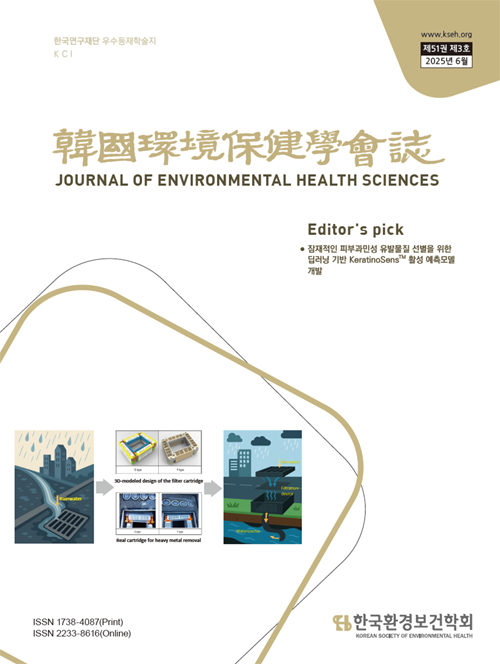- 영문명
- A Study on the Precipitation-Based Removal of Heavy Metals and Sludge Reduction from Electroplating Wastewater Using FeS4
- 발행기관
- 한국환경보건학회
- 저자명
- 정승훈(Seung-Hun Jung) 신현상(Hyun-Sang Shin)
- 간행물 정보
- 『한국환경보건학회지』제51권 제3호, 165~171쪽, 전체 7쪽
- 주제분류
- 공학 > 환경공학
- 파일형태
- 발행일자
- 2025.06.30

국문 초록
Background: Electroplating processes generate wastewater containing high concentrations of heavy metals such as copper, zinc, nickel, and hexavalent chromium. These metals are non-biodegradable and tend to accumulate in organisms, posing serious environmental and health risks. Conventional treatments like hydroxide precipitation are widely used, but they often result in excessive sludge generation and limited removal efficiency under varying conditions.
Objectives: This study aims to evaluate the feasibility of using sulfur-rich iron sulfide (FeS4) as an effective and environmentally friendly precipitating agent for removing heavy metals from electroplating wastewater. It also investigates the potential of FeS4 to reduce sludge production compared to the conventional hydroxide method, while also preventing the formation of hydrogen sulfide (H2S) gas.
Methods: Laboratory-scale batch experiments were conducted using synthetic electroplating wastewater containing Cu2+, Zn2+, Ni2+, and Cr6+. The effects of pH (5.0~9.0) and FeS4 dosage (0.5~2.0 g/L) on removal efficiency and sludge generation were examined. Metal concentrations were analyzed using ICP-OES, and sludge volume was measured after drying.
Results: The optimal condition was observed at a pH of 8.0 and with 1.5 g/L of FeS4, achieving removal efficiencies of 96.3% for Cu2+, 93.8% for Zn2+, 91.5% for Ni2+, and 87.9% for Cr6+. Compared to the hydroxide precipitation method, sludge volume was reduced by approximately 40%, and no hydrogen sulfide gas was detected during the process.
Conclusions: The FeS4-based precipitation process shows strong potential for industrial application in electroplating wastewater treatment. It provides high removal efficiency, reduced sludge generation, and safer operation without H2S gas emission, making it a viable and sustainable alternative to conventional treatment methods.
영문 초록
목차
Ⅰ. 서 론
Ⅱ. 재료 및 방법
Ⅲ. 결과 및 고찰
Ⅳ. 결 론
References
해당간행물 수록 논문
참고문헌
- J Environ Manage
- Korean J Chem Eng
- J Hazard Mater
- Chem Eng J
- Am J Environ Prot
- Sci Total Environ
- the encyclopedia of water science
최근 이용한 논문
교보eBook 첫 방문을 환영 합니다!

신규가입 혜택 지급이 완료 되었습니다.
바로 사용 가능한 교보e캐시 1,000원 (유효기간 7일)
지금 바로 교보eBook의 다양한 콘텐츠를 이용해 보세요!



